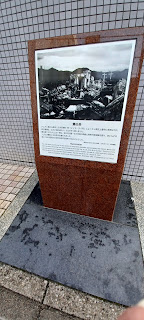A visit to Hiroshima was a non-negotiable destination in Japan. How could we not visit a place that the United States destroyed and view how the city has risen from the ruins of that tragic day. While we were not alive when the U.S. dropped the atomic bombs, we can’t help but feel connected with what happened. We’ve had many opportunities during our trip to reflect on history, colonialism, and the impact of US foreign policy and war. Hiroshima provided yet another chance to consider our place in the world and how we are so fortunate.
Hiroshima is a large and thriving metropolis now. It has been completely rebuilt and its population has grown significantly from its pre-WWII size. Historically, even during the Shogun era, the city was a place where military supplies were organized. Now, however, the city has become a dedicated advocate for peace and many of its sites are focused on this mission.
We spent one day visiting the peace-related sites. The Hiroshima Peace Memorial Museum tells the story of the city just before, during and after the bomb. The museum is surrounded by numerous monuments and markers, including the Flame of Peace, Cenotaph and National Memorial Hall for the Atomic Bomb Victims.
Several markers of importance could easily be missed if you aren’t paying attention, including one showing the hypocenter (the point above which the bomb exploded) and others noting residual shadows of the impact of the bomb, like the buddha statue in the photo.
We enjoyed speaking with Mito Kosei, one of the youngest survivors of the bomb. His mother was four months pregnant with him at the time. Amazingly, at 104 years old, she is still alive. Mito is a wealth of information and a passionate anti-nukes activist. Mito volunteers his time as a guide in front of the A-Bomb Dome, the most famous surviving building in Hiroshima, which has been left exactly as it was after the bombing.
Inside the museum is a clock that is reset each time a nuclear bomb is tested. Next to the clock was a sternly worded letter from the mayor of Hiroshima to President Biden, taking him to task for the test that reset the clock most recently. Perhaps, the mayor will have a chance to restate his message this year with the G-7 leaders' meeting taking place in Hiroshima. Ironically, while Biden and other world leaders are meeting, a US Marine will carry the “nuclear football” to a city that wants nuclear weapons eliminated. (The photo Mito had of Obama speaking in Hiroshima about peace and nuclear disarmament with the football behind him is the definition of irony and hypocrisy.)
Our second day was less contemplative. We visited the rebuilt Hiroshima Castle, which is an example of a flatland castle. The original was built in the late 16th century. We were lucky to watch a hawk or falcon soaring above the five-story castle.
We also enjoyed the Shukkei-en Gardens, a traditional garden in the center of the city dating back to 1620. The name translates to “shrunken-scenery garden”. Some of the plum trees were just starting to bloom, which was a treat as the January scenery was otherwise barren.Hiroshima is a worthy destination and we were glad we went. It is unfortunate that the world has not learned much from the destruction wrought by nuclear weapons, especially when the current bombs are far more powerful than those dropped on Japan in 1945.
Peace,
Shana & Jeff




































.jpg)


















